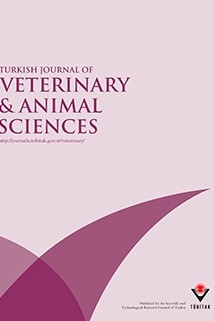
Turkish Journal of Veterinary and Animal Sciences
Yazarlar: Hidayet Metin ERDOĞAN, Ahmet ÜNVER, Mehmet ÇİTİL, Vehbi GÜNEŞ
Konular:-
Anahtar Kelimeler:Neonatal calves,Morbidity,Mortality
Özet: The study was designed to determine the health status of neonatal calves on dairy farms in Kars district. It involved retrospective questioning (2001 calving season) and prospective follow up (2002 calving season). The localities and farms were selected from a list using a 2-stage stratified random sampling method. Farms were weekly visited by authors during the 2002 calving season for clinical problems. A total of 624 calves, born on 45 farms from 7 different localities, were followed up in the 2002 calving season. On the same farms data were collected regarding 582 neonatal calves in the 2001 calving season by questionnaire. The overall morbidity in 2002 and 2001 was 51.1% and 36.3%, respectively. The morbidity of diarrhoea, omphalitis, pneumonia, premature birth, omphalitis-enteritis complex, and pneumonia-enteritis complex were 24.4%, 13%, 3.4%, 2.4%, 2.4%, and 1% in 2002, and 17.4%, 1.4%, 6.2%, 0%, 2.7%, and 6% in the 2001 calving season, respectively. Clinical problems of trauma, umbilical hernia, complicated hernia, and an unknown reason were also diagnosed at low proportion. The overall mortality determined in 2001 and 2002 was 10.5% and 6.7%, respectively. The most common causes of mortality were diarrhoea (2.2%), premature birth (2.1%), and trauma (0.8%) in 2002 while diarrhoea (7.7%), pneumonia (0.7%), and Foot and Mouth Disease (1.4%) were most common in 2001. Additionally, deaths due to pneumonia, omphalitis, congenital deformation, and an unknown reason were also experienced. Age distribution of cases revealed that diarrhoea and omphalitis were common in the first 2 weeks of life while pneumonia was more frequent in the 4th week of neonatal life. A positive association between group size and disease existence was determined. Of the cases examined, 12.9% (12/93) had the failure of passive transfer while all controls had adequate colostrums (0/45). The study revealed that a considerable proportion of calves suffer from at least 1 clinical problem during neonatal life and around 1 in tenth die, resulting in detrimental effects on farm profitability.